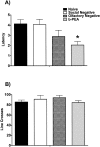Social modulation of associative fear learning by pheromone communication
- PMID: 19117912
- PMCID: PMC2632855
- DOI: 10.1101/lm.1226009
Social modulation of associative fear learning by pheromone communication
Abstract
Mice communicate through visual, vocal, and olfactory cues that influence innate, nonassociative behavior. We here report that exposure to a recently fear-conditioned familiar mouse impairs acquisition of conditioned fear and facilitates fear extinction, effects mimicked by both an olfactory chemosignal emitted by a recently fear-conditioned familiar mouse and by the putative stress-related anxiogenic pheromone beta-phenylethylamine (beta-PEA). Together, these findings suggest social modulation of higher-order cognitive processing through pheromone communication and support the concurrent excitor hypothesis of extinction learning.
Figures




References
-
- Burchett S.A., Hicks T.P. The mysterious trace amines: Protean neuromodulators of synaptic transmission in mammalian brain. Prog. Neurobiol. 2006;279:223–246. - PubMed
-
- Chen D., Katdare A., Lucas N. Chemosignals of fear enhance cognitive performance in humans. Chem. Senses. 2006;31:415–423. - PubMed
-
- Cordero M.I., Venero C., Kruyt N.D., Sandi C. Prior exposure to a single stress session facilitates subsequent contextual fear conditioning in rats. Evidence for a role of corticosterone. Horm. Behav. 2003;44:338–345. - PubMed
Publication types
MeSH terms
Substances
LinkOut - more resources
Full Text Sources
